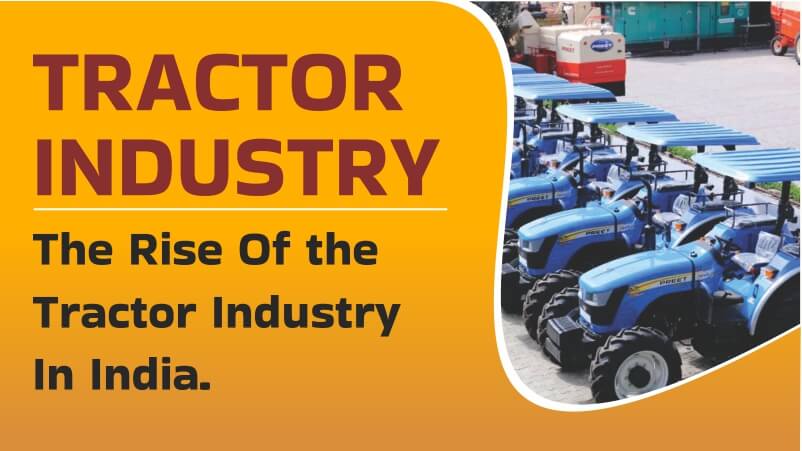Introduction:
Tractor output peaked in 1961 at 880 units annually, and the main producers at the time included Eicher, Gujrat Tractors, TAFE, Escorts, and M&M. Farmers’ access to credit got better over time, and the tractor industry grew quickly-from a total use of more than 500,000 units in 1980 to nearly 700,000 units annually in 2020. India currently produces roughly 20% of the world’s tractors.
Even in countries with a long history of tractor production and with numerous government regulations in place to help it properly fulfil demand, India’s rise remains perfect.
Farm mechanisation techniques have advanced significantly in recent years. Tractors and other farm equipment are heavily utilized to address issues relating to farm productivity. The use of automated power in the field has led to significant changes in the nation’s agriculture industry. The Indian government, state governments, state agro-industries corporations, associations of machinery manufacturers, Farm Machinery Testing and Training Institutes (FMTTIs), manufacturers, importers, dealers, and farmers are all involved in providing the subsidy. The market subsidy for agricultural mechanization is split between the federal government and the state governments under direct benefit transfer.
Many financial institutions, led by beneficent government policies and subsidy programmes, make it feasible for farmers to easily get financing. Funding for automation is provided by various financing programmes, simple instalment breakdowns based on crop cycles, and low-interest payment plans. Any farmer in India who owns 8 acres of land is eligible to apply for a tractor loan from the National Bank for Agriculture and Rural Development (NABARD), which must be repaid over a nine-year period with 12.5 % interest added to the principal. Small farmers were able to purchase the equipment thanks to various advantages from the Indian government, including the removal of excise duty for tractors with a capacity of less than 1800 cc.
Market Overview:
Over the forecast period, 2022–2027, the India Agricultural Tractor Market is anticipated to see a CAGR of 8.9 %.
Due to COVID-19’s effects, the tractor industry in India was mostly unharmed; sales of tractors in India only started to decline in April 2020 as a result of lockdown regulations. The demand for agricultural machinery, including tractors, increased throughout the remainder of 2020 and into 2021 as a result of higher Kharif sowing, favourable cash flows to farmers, a timely and typical monsoon across the nation in June and July, continued increases in rural government spending, and the absence of lockdown restrictions.
Long-term growth in tractor volume is probably due to government initiatives for rural development, farm mechanisation, and several variables like high rural salaries and a lack of farm workers. India is one of the world’s top tractor markets in terms of units, selling an average of 600,000 to 700,000 tractors annually between 2016 and 2021.
In the Indian market, two-wheel drive tractors are observed to be more prevalent than four-wheel drive tractors. Indigenous Indian OEMs like Mahindra & Mahindra Limited, TAFE, International Tractors Ltd (Sonalika), and Escorts Limited dominate the market for agricultural tractors. Important international tractor producers like Deere & Company and CNH entered the market and built a respectable market position.
Increasing Competition
Large international and domestic manufacturers dominate the agricultural tractor industry in India, where farmers favour reputable brands for the certainty of superior quality and after-sales support. The market leader in terms of market share for agricultural tractors in India is Mahindra & Mahindra Ltd, which is followed by Tractor and Farm Equipment Ltd (TAFE), International Tractor Ltd, and Escorts Limited. For business expansion, these key firms are investing in new products, product innovation, expansions, and acquisitions. The emphasis on R&D to introduce new items at cheaper prices represents another significant area of expenditure.
Tractor OEMs are competing to provide farmers with better value propositions in order to stay competitive in a market where value is highly valued.
- The 31 to 50HP group accounts for more than 80% of tractor sales.
- With 17.4% of the industry share, Uttar Pradesh maintained its top spot in tractor sales.
- The top ten states account for 83 % of the industry share.
Companies in the Indian tractor industry are introducing vehicles with appealing features at affordable price points. The following segments typically make up the Indian tractor market:
20 to 30 HP, 31 to 40 HP, 41 to 50 HP, and more than 50 HP.
The 31 to 50HP group accounts for more than 80% of tractor sales. Both the > 50 HP and the 20 HP segments have had strong growth over the last ten years (F10 to F20). The necessity for tractor adaptability and the development of farming techniques, particularly for farmers with large land holdings, are driving factors behind the expansion in the > 50HP market.
Farmers with small- to medium-sized land holdings now have access to more affordable machines, and the need for mechanisation is rising. The agricultural economy’s horticulture sector is expanding. Over the past few years, horticulture production has steadily increased.
The domestic tractor market deviated slightly from the historical pattern, growing at a CAGR of 6% from F10 to F20. After three years of straight expansion from FY2016 to FY2019, the tractor industry experienced a drop in FY2020.
Regional Analysis:
According to reports, there is a greater need for agricultural tractors in the northern and western states than in the southern and eastern regions of the nation. Additionally, the states in the northern region of the nation are more mechanised than any other region. As a result, it may be said that the north zone market is moving toward saturation. Therefore, it is anticipated that the southern region of the country will have a high need for agricultural tractors.
For more information on tractor, tractor price, tractor videos, tractor games vist khetigaadi mobile application.




